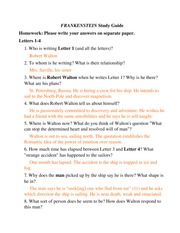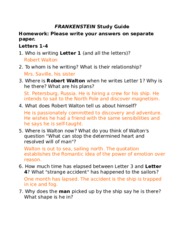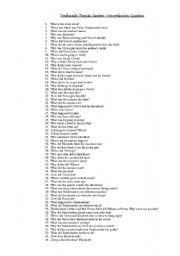Frankenstein Study Guide Answer Situation
Preface and Letters 1–4 Summary: Preface I saw the pale student of unhallowed arts kneeling beside the thing he had put together. (See ) Frankenstein opens with a preface, signed by Mary Shelley but commonly supposed to have been written by her husband, Percy Bysshe Shelley. It states that the novel was begun during a summer vacation in the Swiss Alps, when unseasonably rainy weather and nights spent reading German ghost stories inspired the author and her literary companions to engage in a ghost story writing contest, of which this work is the only completed product. Summary: Letter 1 What may not be expected in a country of eternal light? The novel itself begins with a series of letters from the explorer Robert Walton to his sister, Margaret Saville.

Frankenstein Study Guide Answer Situational Leadership
Walton, a well-to-do Englishman with a passion for seafaring, is the captain of a ship headed on a dangerous voyage to the North Pole. In the first letter, he tells his sister of the preparations leading up to his departure and of the desire burning in him to accomplish “some great purpose”—discovering a northern passage to the Pacific, revealing the source of the Earth’s magnetism, or simply setting foot on undiscovered territory. Summary: Letters 2–3 In the second letter, Walton bemoans his lack of friends. He feels lonely and isolated, too sophisticated to find comfort in his shipmates and too uneducated to find a sensitive soul with whom to share his dreams. He shows himself a Romantic, with his “love for the marvellous, a belief in the marvellous,” which pushes him along the perilous, lonely pathway he has chosen. In the brief third letter, Walton tells his sister that his ship has set sail and that he has full confidence that he will achieve his aim.
Official Dodge Owners website. Your source for Dodge Owner Manuals and Dodge Service Manuals. Dealers & Vehicles; BUILD & PRICE. ALL DODGE VEHICLES. Includes Manuals from 2004 Through the. We have the answers in this downloadable manual. Select Vehicle Type. Dart SXT Dodge Deals. Service manual for dodge magnum v6 2004. Haynes Dodge repair manuals cover your specific vehicle with easy to follow pictures and text, save thousands on maintaining your. Dodge is also a popular brand when it comes to pickup trucks. Dodge Charger. Dodge Dakota 1997 - 2004. Wiper blade replacement Dodge Ram 1500 2002 - 2008 Petrol 3.7 V6.

Summary: Letter 4 In the fourth letter, the ship stalls between huge sheets of ice, and Walton and his men spot a sledge guided by a gigantic creature about half a mile away. The next morning, they encounter another sledge stranded on an ice floe. All but one of the dogs drawing the sledge is dead, and the man on the sledge—not the man seen the night before—is emaciated, weak, and starving. Despite his condition, the man refuses to board the ship until Walton tells him that it is heading north. The stranger spends two days recovering, nursed by the crew, before he can speak. The crew is burning with curiosity, but Walton, aware of the man’s still-fragile state, prevents his men from burdening the stranger with questions.
As time passes, Walton and the stranger become friends, and the stranger eventually consents to tell Walton his story. At the end of the fourth letter, Walton states that the visitor will commence his narrative the next day; Walton’s framing narrative ends and the stranger’s begins. Analysis: Preface and Letters 1–4 The preface to Frankenstein sets up the novel as entertainment, but with a serious twist—a science fiction that nonetheless captures “the truth of the elementary principles of human nature.” The works of Homer, Shakespeare, and Milton are held up as shining examples of the kind of work Frankenstein aspires to be.

Study Questions For Frankenstein
Incidentally, the reference to “Dr. Darwin” in the first sentence is not to the famous evolutionist Charles Darwin, who was seven years old at the time the novel was written, but to his grandfather, the biologist Erasmus Darwin. In addition to setting the scene for the telling of the stranger’s narrative, Walton’s letters introduce an important character—Walton himself—whose story parallels Frankenstein’s. The second letter introduces the idea of loss and loneliness, as Walton complains that he has no friends with whom to share his triumphs and failures, no sensitive ear to listen to his dreams and ambitions. Walton turns to the stranger as the friend he has always wanted; his search for companionship, and his attempt to find it in the stranger, parallels the monster’s desire for a friend and mate later in the novel. This parallel between man and monster, still hidden in these early letters but increasingly clear as the novel progresses, suggests that the two may not be as different as they seem.